Adventures of a Native Plant Gardener: Scilla in the Spring
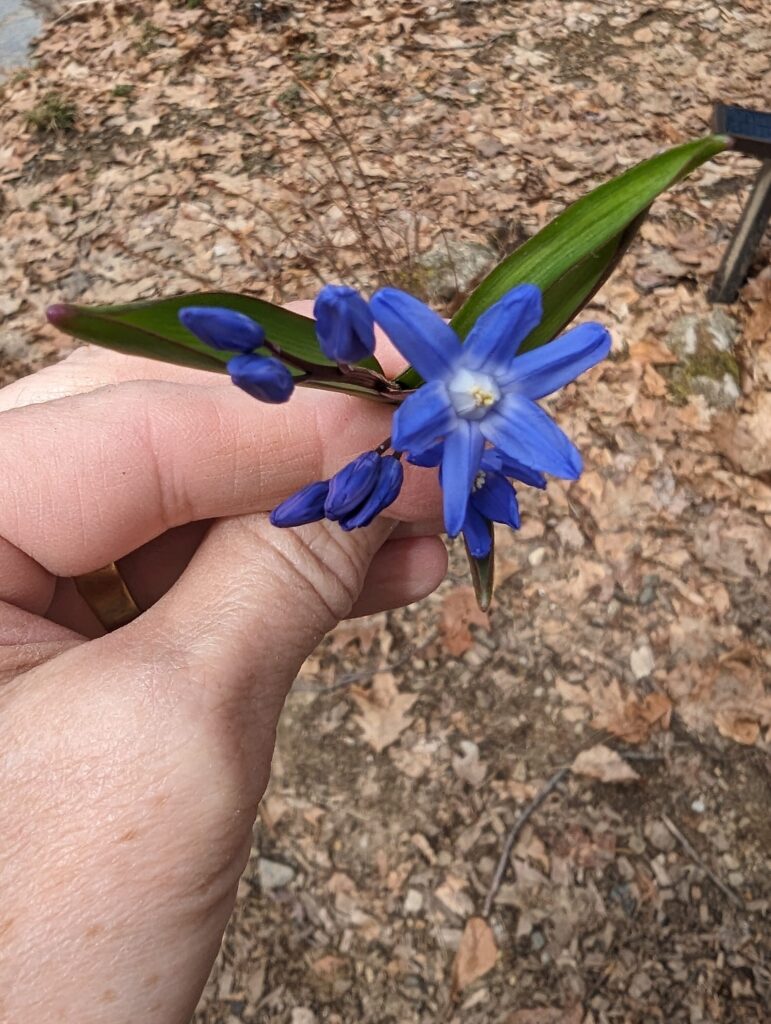
Invasive but beautiful: Scilla’s floral starriness is in full view here, along with several buds. Scilla’s grassy leaf blades are also quite attractive! Photo: Laura Quilter
For the past couple of weeks, I’ve been enjoying – and simultaneously destroying – a literal efflorescence of Siberian Squill, Scilla siberica (also called Othocallis siberica or “spring scilla”) – and its close cousin, Scilla section Chionodoxa (glory of the snow). Scilla are lovely grassy bulbs that make beautiful little starry purple flowers – anywhere from 2” to about 6”. From a purely aesthetic perspective, I like almost everything about them – the grass blades have a nice two-toned effect, and the flowers are simple, spikey, purple. I even like the name – squill, so beautifully alliterating with Siberian.
Yet – here I am, full curmudgeon on these little plants, ripping them out, hoping to stem their tide across my semi-natural wooded yard.
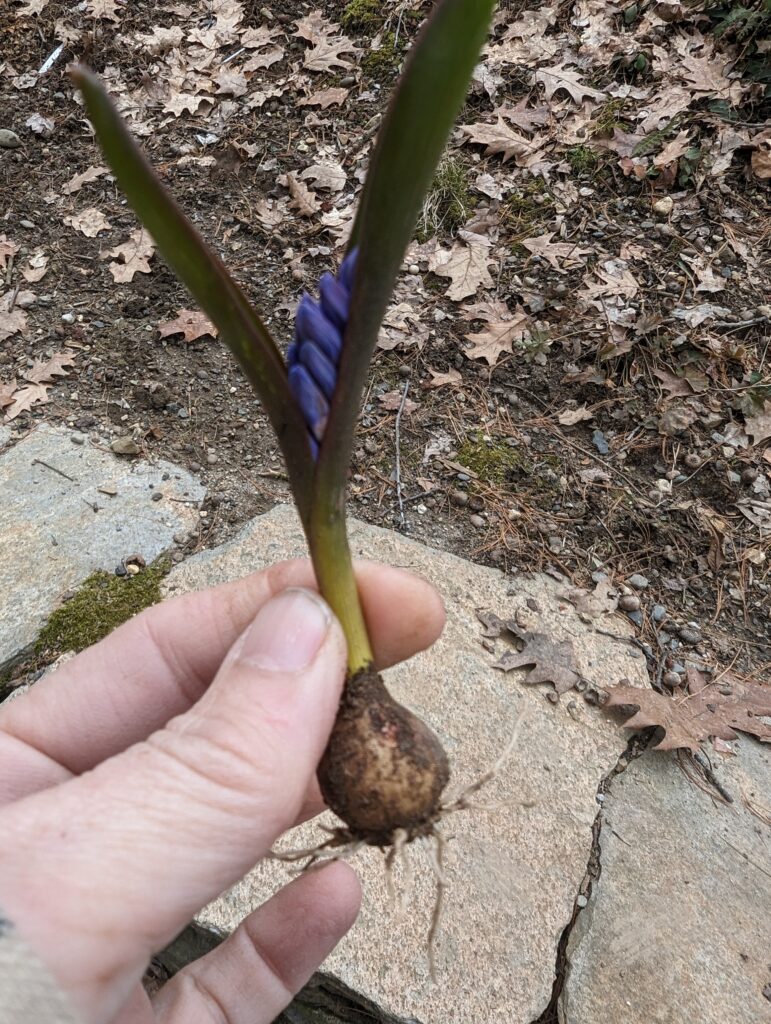
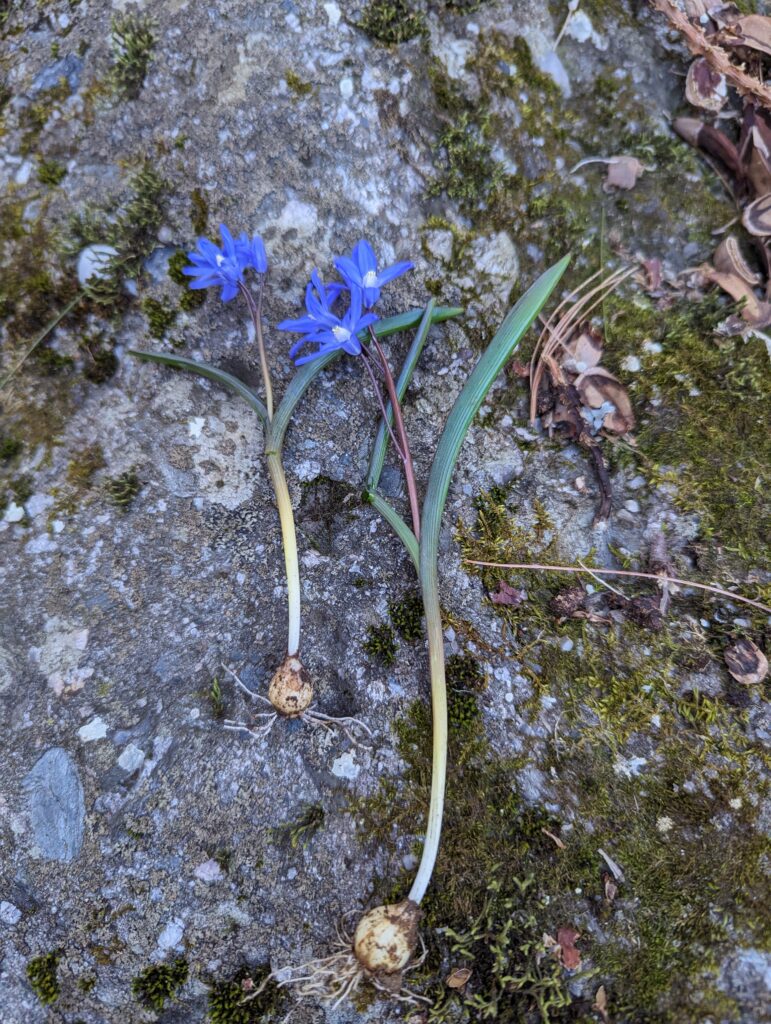
Why am I, a confirmed pacifist, being unkind to these individual flowers? Well, as their name indicates, they hail from Eurasia, although the name is actually misleading; Siberian squill is native to Eastern Europe (Turkey, Russia, Caucasus), not Siberia. Scilla’s nativity, combined with its robustness and rapid spread, means it is displacing other plant life in the little corner of the world of which I am custodian. Scilla siberica is considered invasive in several states (not yet Massachusetts), and it (or its cousin Chionodoxa) are certainly advancing significantly on my property.
When I moved to Amherst in 2012, my home had been relatively untended for a few years. The master gardeners who had first built and lived in this home, Ruth and Hal Rauch, had aged in and out of the home they had built, and it had been effectively unoccupied for several years. That was enough time for a veritable forest of invasive plants to take over the beautiful paths, rock walls, rain garden, and even the woodsy parts. The notorious burning bush, bittersweet, autumn olive, and alder buckthorn occupied probably a quarter of the property, spread among the native red oak, black cherry, hickory, Eastern white pine, and sugar maples. The imported ornamental groundcovers the Rauches had planted had escaped and run amok. What were no doubt once carefully-tended beds of Pachysandra terminalis (the non-native Pachysandra), Vinca minor (aka myrtle), and English ivy (Hedera helix), had obscured stonework and plant beds.
I had lived in city apartments for my entire adult life – no gardens, not even balconies. I was a life-long environmentalist, with a certain penchant for trees, but was an entirely novice gardener. So I leaned upon friends – especially my botanist friends at Amherst College, Rachel Levin and Jill Miller (faculty, Dept. of Biology & Environmental Studies), as well as local gardeners and garden designers, and started learning just what this and that and that other thing was. I was sometimes pleasantly surprised – those wonderfully cool plants are trilliums and that delightfully goth, deep red bloom is a Calcycanthus floridus (Carolina allspice). But also, very often, I was disappointed – so many plants were invasive! I began to see, in real-time, why scientists are so concerned about displacement of native plants, and their immediate dependents – insects and birds.
Scilla siberica was one of the disappointing moments. It was so adorable, that first spring in my new home – popping up here and there, star-like and grassy. It was one of the earliest flowers I saw, and not too common. My disappointment at learning that Scilla wasn’t some rare native, but imported and somewhat invasive, was brief; soon enough, I noticed violets – even I, a recent urbanite, recognized violets by sight – and then, boom, a spring flood of blooms, all of which needed identifying and understanding. In 2013, I didn’t have convenient plant ID apps, so each identification required research and dependence upon the kindness of gardeners. With a new job and a little kid and a lot of deferred maintenance on the home, those first years I contented myself with learning about plants, and removing the worst offender – bittersweet (Celastrus orbiculatus), which was dragging down and choking the life out of a number of my trees.
Frankly, that was enough. Confession: I wasn’t even sure if I wanted to be a gardener. I had very little time, and maybe not much inclination. Yes, as a lifelong environmentalist, I had absorbed some information about the importance of native plants – but not very much. I had half-formed ideas that if I cleared out some of the non-native plants, such as bittersweet, maybe the natives would come roaring back, and I could have a no-maintenance, native woodland, supporting native birds. That was the extent of my vision! So, for years, I tinkered, clearing out just enough Pachysandra terminalis to uncover stone paths and walls, slowly identifying and then uprooting this or that invasive shrub or vine.
But it became clear that the low- or no-maintenance approach wasn’t working. The burning bush, bittersweet, autumn olive (or was it silver olive?), and buckthorn kept coming back, and in the meantime, the pachysandra and vinca had begun to take over the entire backyard. I wasn’t seeing violets in the spring any more. A lot of the other plants I had identified as natives were diminishing, too. I started working more assiduously, identifying plants, clearing patches of overgrown invasives (with the help of UMass students), and actively replacing non-natives with natives from Nasami (the Native Plant Trust, formerly the New England Wildflower Society).
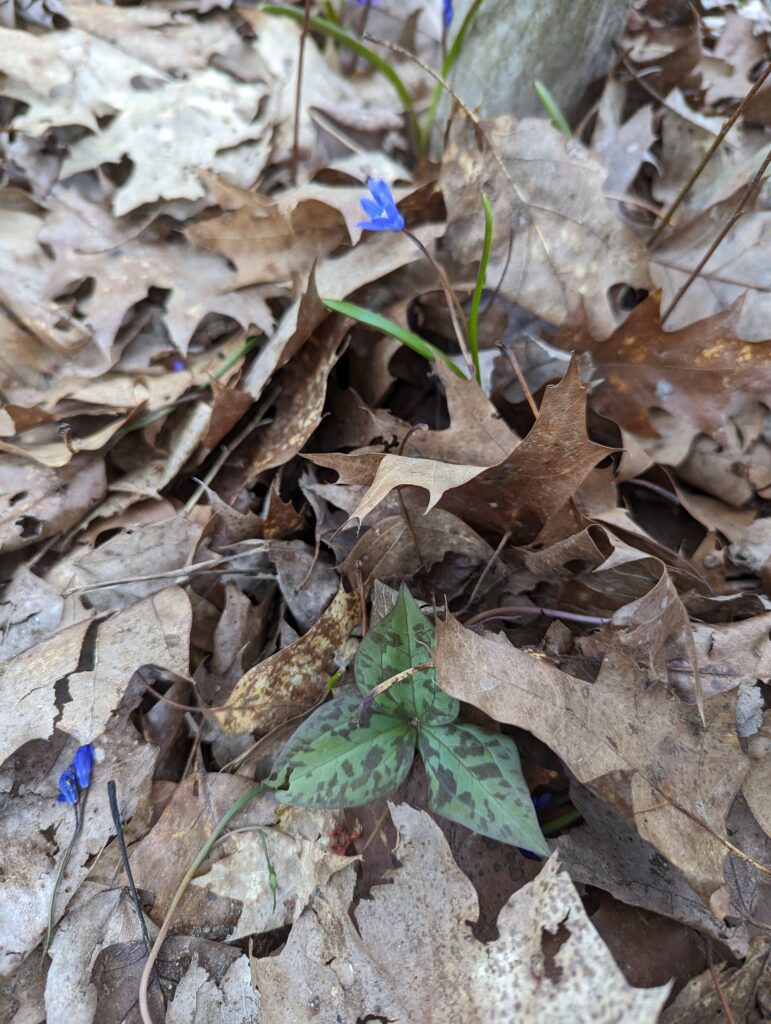
Over the past five years, I’ve taken out a lot of the obvious and most harmful invasives, reclaiming territory for the violets, the trilliums, the spotted wintergreen (Chimaphila maculata), Canada mayflower, Solomon’s plume, solidago, and native asters, among others. I’ve been thrilled to see these natives thriving in the woodland setting, supporting the bees and caterpillars that need those particular kinds of native plants, and in turn supporting the native birds.
Over these same years, though, Scilla, with its little star-shaped springtime pops of color, was spreading. Last year, the low-lying section of my yard that I call “fern valley” was covered with Siberian squill. That was the first time that I started to wake up and notice that it wasn’t just here and there – like Roy Kent in “Ted Lasso”, it was every f*ing where.
When Scilla started appearing a couple of weeks ago, I started reading.
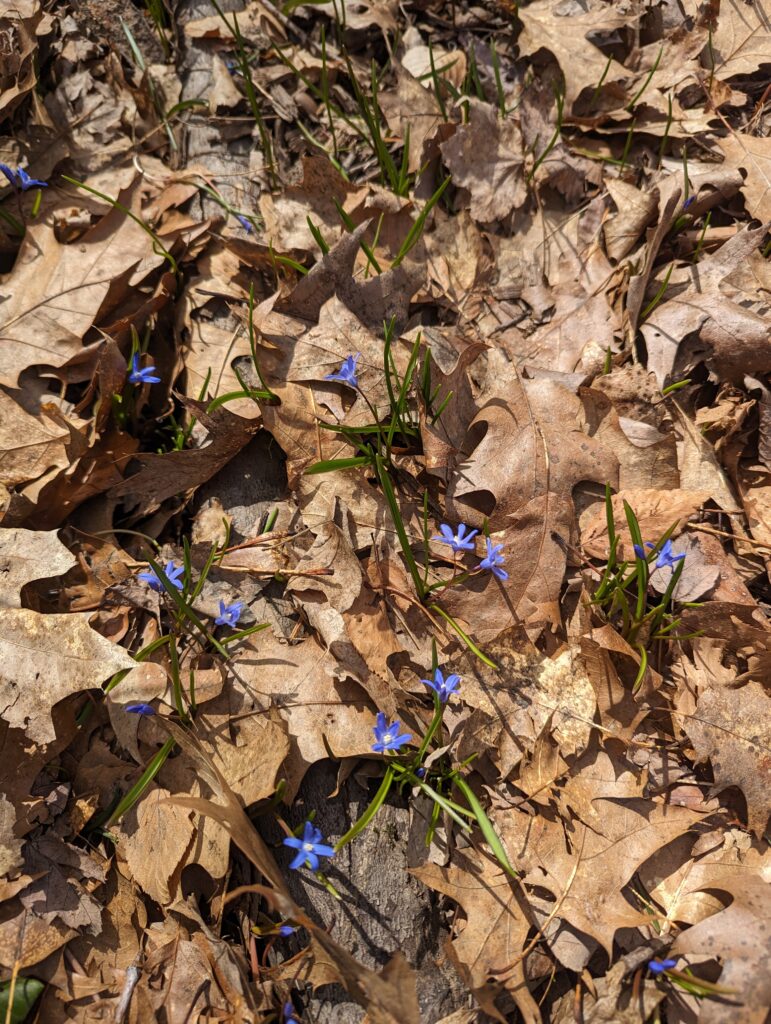
Siberian squill forms large colonies – google “scilla carpet” to see some examples. And, yes, it’s invasive – meaning, it spreads readily and displaces native plants. And no, it is not an adequate substitute in the food webs for the plants it’s displacing. Scilla’s cousin, Chionodoxa, hasn’t been deemed officially invasive, but the combination of the two were definitely sweeping across my yard. As pretty as it is, the rapidly-forming carpet would definitely displace all the spring ephemerals that the local bees and insects actually need.
So – along with spring raking (all those native oak leaves love piling up along my house) I have added Scilla pulling.
(This paragraph was edited after publication to include a correction from a commenter.) I had thought that Scilla doesn’t require any special treatment – unlike, say, knotweed, which is so easy to spread that chopping it, mowing it, or composting it, can all contribute to its spread – so I was just pulling it up, and I left it laying on the ground, so as to still appreciate the purple color. Commenter Tara Rose, below, however, says Scilla does need to be disposed of carefully!
I’m still enough of a non-gardener to feel guilty about pulling out plants. But I’m looking forward to those violets in just a few weeks.
This is the first column in an occasional series documenting my adventures as a novice native plant gardener. I feel a sense of hubris even claiming the term “native plant gardener,” especially in this Western Massachusetts community filled with gardeners, environmentalists, and native plant experts. But I don’t think I’m alone on this journey, and I want to share what I’m learning.
I would love to hear from my neighbors – experts and fellow novices alike. Do you, too, have a love-hate relationship with Scilla? Are you keeping it, cultivating it, eradicating it, failing to notice it? Can you tell the difference – and help me tell the difference – between S. siberica and Scilla sect. Chionodoxa?
Further reading about Scilla:
- Scilla (the genus), Wikipedia
- Scilla siberica, Wikipedia
- Othocallis siberica, at the Native Plant Trust – An excellent description with a lot of botanical detail that is, frankly, above my head.
- Siberian Squill, MinnesotaWildflowers.info – which notes, “Invasive – ERADICATE!”
- Squill, University of Minnesota Extension
- “Highly Invasive Spring Scilla”, Donna VanBuecken, Accent on Natural Landscaping, April 21, 2016
- Siberian Squill, Indiana Invasive Species Week 2022
Laura Quilter is a resident of Amherst, librarian, lawyer, parent, and contributor to the Indy.

I have 14 years of experience battling squills in a 20 acre woods, and hope some of what I’ve slowly learned the hard way might be of help.
For one thing, unfortunately, the bulbs do not die just from being dug up and left on the surface. In fact, doing so can actually spread them to a wider area even faster, when heavy rains wash them downhill or squirrels gather them up and bury them elsewhere.
The best approach is to collect the bulbs in a bucket as you go. They can then be dumped in a single pile, and covered with a piece of landscape fabric. Eventually, deprived of light, they die and compost under there. Other people have had success burying them in a HOT working compost pile, or cooking them in the sun under clear plastic to kill them before composting (if the pile itself isn’t hot enough.)
Another tip: Squills spread by seed FAR more readily than you would expect, so don’t make the mistake of letting any of them go to seed. If you don’t have time to dig every one (sometimes they are deep in rocky soil and it’s difficult) at least pick the flowers off the rest, which buys you another year to get around to digging them.
Finally, if you have any dense patches that aren’t mixed in with native plants, they can be covered with landscape fabric for three to five years, which is a much easier alternative to hand removal when dealing with tens of thousands of them.
Oh, and I agree they are absolutely gorgeous! It makes me sad having to kill them, but I just remind myself that flowers don’t exist for human enjoyment. They really are one of the worst in terms of crowding out rare natives, so sadly, they have to go.
Tara! Thank you for telling me — I was being so casual after digging them up. Back to work!
And also — holy wow — 20 acres, that’s so hard. Thank you for your work!